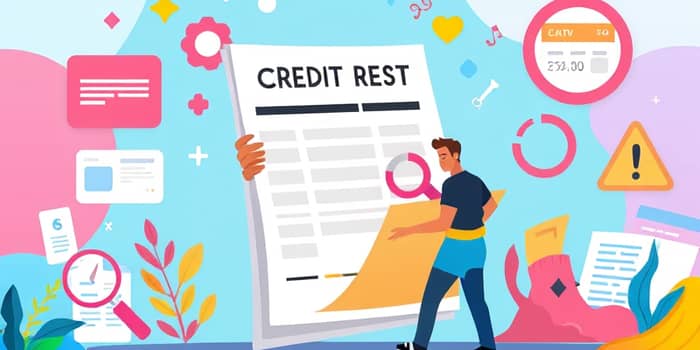Your credit report is a powerful tool that influences your financial opportunities every day. By learning how to read it properly, you gain complete visibility into your credit health and can take control of your financial destiny.
In this guide, you’ll discover each section of a credit report, understand how it affects your score, and learn practical steps to protect your information and correct any inaccuracies.
What Is a Credit Report?
A credit report is a comprehensive summary of your credit and financial history. It details your borrowing habits, repayment performance, and any public records that relate to your creditworthiness. Major agencies like Experian, Equifax, and TransUnion compile these reports based on information from banks, lenders, and public records.
Think of your credit report as a snapshot of your financial behavior over time. Lenders and other institutions use it to assess your likelihood of repaying debts, set loan terms, and determine interest rates.
Key Sections Explained
Every credit report contains several core sections that paint a detailed picture of your financial life. Reviewing each area carefully ensures you catch errors and identify opportunities for improvement.
- Personal Information: Includes your name, current and previous addresses, date of birth, Social Security number, phone numbers, and employment history.
- Credit Accounts (Trade Lines): Lists active and closed accounts from the past seven to ten years, including revolving credit, installment loans, and mortgage details.
- Collections and Public Records: Shows debts sent to collections, bankruptcies, foreclosures, and any court judgments or tax liens.
- Credit Inquiries: Divides into hard inquiries (impacting your score) and soft inquiries (for informational purposes).
Understanding each category will help you pinpoint potential red flags and inaccuracies that might harm your credit profile.
How Your Report Influences Your Score
Your credit report details feed directly into scoring models like FICO and VantageScore. Each aspect carries a specific weight, reflecting its importance in predicting your credit risk.
For example, a single late payment can linger on your report for seven years and significantly impact your score. High balances relative to your limits also raise red flags for lenders.
Steps to Analyze Your Report
Regular review of your credit report empowers you to spot and address problems early. Follow these steps:
- Obtain reports from all three bureaus at least once a year.
- Verify personal data: confirm your name, SSN, addresses, and employment details are accurate.
- Cross-check each account’s details: lender name, account number, open/close dates, credit limits, balances, and payment history.
- Note any unfamiliar entries or discrepancies, which could indicate fraud or reporting errors.
If you find suspicious accounts or inaccuracies, act swiftly to minimize damage.
Correcting Errors: Disputing Mistakes
Errors on your credit report are more common than you might think. According to studies, nearly one in five reports contains at least one significant mistake. Disputing inaccuracies promptly can restore your true credit standing.
Here’s how to file a dispute:
1. Gather supporting documentation such as payment receipts, bank statements, or court documents.
2. For online disputes, use the credit bureau’s official portal. For mail, draft a dispute letter specifying each error and attach copies of your proof.
3. Clearly describe the inaccuracy and request correction or removal. Include account numbers and relevant dates.
4. Send your dispute via certified mail if mailing, or submit electronically and save confirmation numbers.
Bureaus must investigate within 30 days, after which they inform you of the results. If an error persists, escalate the issue by contacting the original creditor or adding a consumer statement to your report.
Practical Tips to Improve and Protect Your Credit
Maintaining a healthy credit profile requires ongoing attention. Here are actionable strategies you can implement today:
- Pay all bills on time every month; set up automatic reminders or recurring payments for consistency.
- Keep credit card balances below 30% of the limit to lower your utilization ratio.
- Limit hard inquiries by spacing out credit applications over time.
- Maintain a mix of credit types—revolving and installment—to demonstrate responsible credit use.
- Monitor your report regularly and consider credit monitoring services or fraud alerts if you suspect identity theft.
By adopting these habits, you can gradually raise your score, unlock better loan offers, and secure more favorable interest rates.
Remember, your credit report is not just a static document—it’s a dynamic reflection of your financial choices. Taking the time to understand, review, and correct it can save you thousands in interest and bolster your financial confidence.
Empower yourself with knowledge, stay vigilant, and watch as your credit profile transforms into one that opens doors rather than closing them.
References
- https://www.myfico.com/credit-education/whats-in-my-credit-report
- https://www.equifax.com/personal/education/credit/report/articles/-/learn/what-is-a-credit-report-and-what-is-on-it/
- https://www.experian.com/blogs/ask-experian/credit-education/report-basics/understanding-your-experian-credit-report/
- https://www.investopedia.com/terms/c/creditreport.asp
- https://www.capitalone.com/learn-grow/money-management/what-is-a-credit-report/
- https://www.experian.com/blogs/ask-experian/credit-education/faqs/how-to-dispute-credit-report-information/
- https://www.canada.ca/en/financial-consumer-agency/services/credit-reports-score/credit-report-score-basics.html
- https://www.bankrate.com/personal-finance/credit/how-to-read-a-credit-report/










